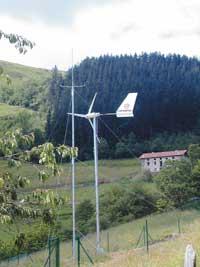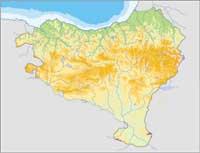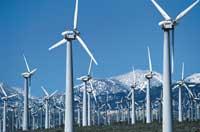The microwind turbine prototype designed and installed by Fatronik is already underway
2003/11/27 Andonegi Beristain, Garazi - Elhuyar Zientziaren Komunikazioa
The Fatronik technology centre has designed and installed a microwind turbine in the Aubixa language centre (San Pedro de Elgoibar district). Since the end of October 2003, the 2.5 kW microturbine has been producing energy.
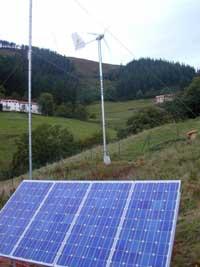
In addition, the production of the microturbine has been added the support of four photovoltaic panels of 120 W. In the first steps, the system will provide power to feed the four boarding houses, illuminate the control cassette, PCs and power the sensors to obtain data. It is a hybrid system that allows an adequate and renewable exploitation of the natural resources of the environment (wind and sun).
The turbine rotor is made up of three fins designed by the Australian company Bolwell Corporation, 2,1 m in length, with an aerodynamic profile selected to work on low Reynolds numbers and a variable torsion angle from root to end. In this way, the angle of incidence with the slope of the wind is kept constant throughout its entire length. The rotor is directly attached to an electric generator of polar permanent magnets (PMG), without an intermediate speed multiplier. The current produced is alternate and variable voltage and frequency. This current is directed to several batteries and is passed by an electric regulator. This electric regulator converts the alternating current into continuous and dissipates excess power. Then the current is transformed back to an alternating voltage of 220V to adjust the power produced to the usual consumption.
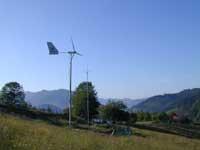
The wind turbine starts the rotation at an approximate wind speed of 3.5 m/s, reaching an approximate speed of 9.5 m/s the nominal power of 2.5 kW. In turn, when the wind exceeds a certain speed (about 16 m/s), the passive control system of the power of the wind turbine is automatically launched. This control is obtained by the articulated assembly between the passive orientation device and the body of the wind turbine. Through this rotor turning braking, the electric infrastructure is protected from overloads and mechanical components are prevented from resisting excessive centrifugal forces.
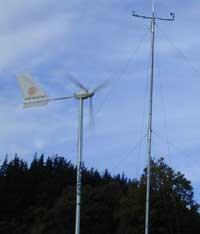
This hybrid micropower level system is designed to work as an isolated application, outside the electric grid. This type of application can be of great use in remote areas of urban, rural or developing areas. In fact, these systems can replace the electric grid when its transmission is costly, ensuring the sustainable development of the territory, extending awareness and respect for natural resources.
On the other hand, the most significant difference with respect to high-power turbines lies in the simplicity of its nature and design: easy to install and maintain, with a low aesthetic impact and fully integrable in the environment. This technology has the main producers and users in the U.S., although it is gradually spreading throughout Spain and Europe.
www.ihobe.net

Gai honi buruzko eduki gehiago
Elhuyarrek garatutako teknologia




